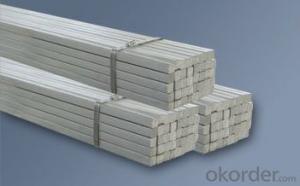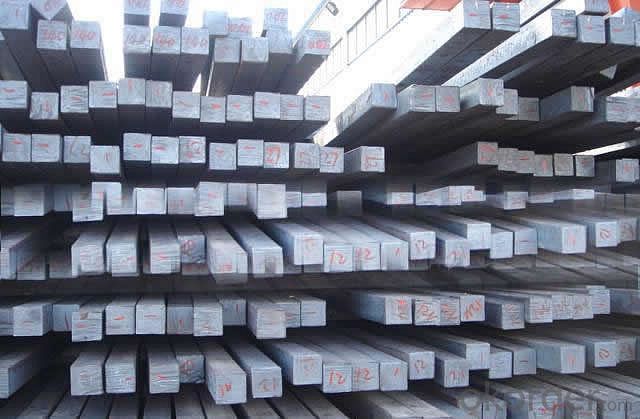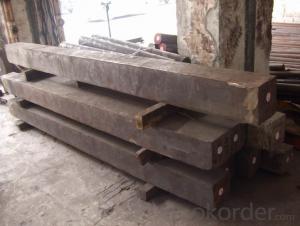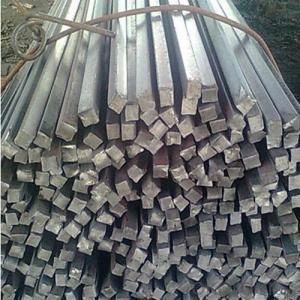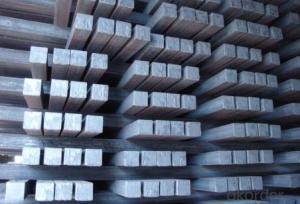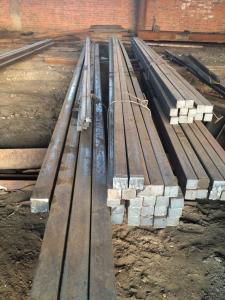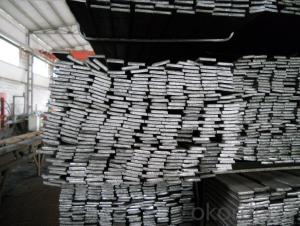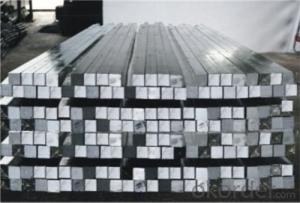Q235B High Quality Steel Square Bar
- Loading Port:
- Tianjin
- Payment Terms:
- TT OR LC
- Min Order Qty:
- 25 m.t.
- Supply Capability:
- 10000 m.t./month
OKorder Service Pledge
OKorder Financial Service
You Might Also Like
square steel billet
1.3SP, 5SP
2.terms of payment: L/C at sight
3.size: 120*120mm
4.length: 5.8~12m
square steel billet
Specifications
square steel billets
1)We procure world class quality steel billets which meets the specific requirements of the clients
The Billets produced by the company can be broadly divided into three main types i.e.
M.S. Billets
CRS Billets
Special Alloy Billets
M.S. Billets are used for rolling of TMT Re-Bars of Fe415 and Fe500 Grade and various other structural steel products.
CRS Billets are used fro rolling of CRS TMT Re-Bars.
Special Alloy Billets are used for rolling of any special grade TMT Re-Bars like Earthquake resistant TMT Re-Bars and for special grade structural steel products.
The following are the sizes of Billets available with Shyam Steel Industries Ltd.:
100 X 100
120x120
150 X 150
Physical Properties:
Description
As per IS 2830
Shyam Billets
Bend (max.) 5 mm per meter >= 5 mm per meter
Carbon (max.) 3mm per meter >= 3 mm per meter
Length 3 mt - 13 mt 3 mt - 9 mt
Chemical Properties:
Ladle Analysis:
Designation
Carbon
Manganese
C15 0.12-0.18 0.30-0.60
C18 0.15-0.21 0.30-0.60
C20 0.17-0.23 0.30-0.60
C15 MMn 0.12-0.18 0.60-1.00
C18 MMn 0.15-0.21 0.60-1.00
C20 MMn 0.17-0.23 0.60-1.00
C15 HMn 0.12-0.18 1.00-1.50
C18 HMn 0.15-0.21 1.00-1.50
C20 HMn
0.17-0.23 1.00-1.50
Billets of different designations are manufactured in three different grades namely A, B, C having sulphur, phosphorous content (on ladle analysis) and carbon equivalent as follows:
Chemical Analysis:
Grade Sulphur Phosphorous Carbon Equivalent (CE)1
Max Max Max
A 0.05 0.05 0.42
B 0.045 0.045 0.41
C 0.04 0.04 0.39
- Q: Can a steel square be used for checking the alignment of metal studs?
- Indeed, the alignment of metal studs can be assessed using a steel square. A steel square, also referred to as a framing square or carpenter's square, is a versatile instrument extensively employed in the realms of carpentry and construction. It comprises two arms, one of which is longer than the other, interconnected at a right angle. The longer arm typically measures around 24 inches, while the shorter arm measures approximately 16 inches. To evaluate the alignment of metal studs, one can position the steel square against the stud's edge or face and ensure its impeccable vertical or horizontal orientation. The longer arm of the square is suitable for aligning the stud's edge, whereas the shorter arm can be employed to align the stud's face. By visually examining and comparing the alignment of multiple studs, one can guarantee their parallelism and straightness, which are crucial for the structural soundness and stability of the constructed wall or structure. Besides alignment assessment, a steel square can fulfill diverse functions related to metal stud installation, encompassing marking and cutting studs, verifying and transferring angles, and measuring distances. Its robust and precise design establishes it as a dependable tool for various applications within the domains of construction and carpentry.
- Q: Can a steel square be used for measuring and marking bevel cuts?
- Yes, a steel square can be used for measuring and marking bevel cuts. The square has angular markings that can help determine the desired angle for the bevel cut. By aligning the square with the edge of the material and marking the desired cut line, accurate bevel cuts can be made.
- Q: Can a steel square be used for checking the squareness of a window frame?
- Yes, a steel square can be used for checking the squareness of a window frame.
- Q: Can a steel square be used for checking the flatness of a wall?
- A wall cannot be checked for flatness using a steel square. A steel square is primarily employed in woodworking and metalworking to measure right angles and create square cuts. It is not intended or appropriate for determining the evenness or flatness of a surface like a wall. To assess a wall's flatness, more suitable tools to use would be a straightedge or a level. A straightedge can be positioned against the wall to identify any deviations or inconsistencies, whereas a level can guarantee the wall's perfect vertical or horizontal alignment.
- Q: What are some common uses for a steel square in woodworking?
- Some common uses for a steel square in woodworking include marking and measuring right angles, checking for squareness, laying out and transferring measurements, and guiding saw cuts.
- Q: What are some common uses of a steel square in metalworking sculpture?
- A steel square, also known as a framing square or a carpenter's square, is a versatile tool that is commonly used in metalworking sculpture for various purposes. Some of the common uses of a steel square in metalworking sculpture include: 1. Layout and marking: A steel square is an essential tool for marking and laying out precise measurements on metal sheets or other materials. It helps in creating straight lines, right angles, and accurate measurements, ensuring the proper alignment and symmetry of the sculpture. 2. Checking for squareness: Metalworking sculptures often require precise angles and right-angled corners. A steel square allows sculptors to check for squareness and ensure that all corners and edges are perfectly aligned, preventing any distortions or irregularities in the final piece. 3. Measuring and transferring dimensions: Metalworking sculptures require precise measurements for cutting, shaping, and joining various components. A steel square enables sculptors to measure and transfer dimensions accurately, ensuring the correct sizing and fit of different parts of the sculpture. 4. Creating miter cuts: Miter cuts, which are angled cuts made on the ends of metal pieces to create clean, tight joints, are a common technique in metalworking sculpture. A steel square aids in marking and cutting precise angles, allowing sculptors to achieve seamless connections between different metal elements. 5. Checking for flatness: A steel square can be used to check the flatness of metal surfaces, ensuring that they are level and even. This is particularly important when working with large metal sheets or when joining different components, as any unevenness can affect the overall stability and appearance of the sculpture. 6. Creating parallel lines: Parallel lines are often required in metalworking sculpture to achieve symmetry or to guide the placement of various elements. A steel square allows sculptors to easily create parallel lines, ensuring uniformity and balance in the design. Overall, a steel square is an indispensable tool in metalworking sculpture, helping artists and craftsmen achieve precision, accuracy, and consistency in their work.
- Q: How do you use a steel square to measure and mark 67.5-degree angles?
- To use a steel square to measure and mark 67.5-degree angles, you can follow these steps: 1. Place the steel square on a flat surface or workbench, ensuring that it is aligned and not tilted. 2. Locate the 45-degree angle on the steel square. This angle is formed by the perpendicular edges of the square. 3. Align one of the edges of the steel square along the edge of the material you want to mark or measure. 4. Use a pencil or a marking tool to mark the material at the intersection of the edge of the steel square and the material. 5. Next, locate the 22.5-degree mark on the steel square. This mark is usually halfway between the 45-degree angle and the right angle (90 degrees) of the square. 6. Align the edge of the steel square with the mark you made in step 4. 7. Hold the steel square firmly in place, ensuring it doesn't move. 8. Use a pencil or a marking tool to mark the material at the intersection of the edge of the steel square and the material. 9. The two marks you made in steps 4 and 8 should form a 67.5-degree angle. 10. Connect the two marks with a straight line or use a protractor to double-check the angle measurement. By following these steps, you can effectively use a steel square to measure and mark 67.5-degree angles.
- Q: What are the markings and graduations on a steel square used for?
- The markings and graduations on a steel square are used for measuring, marking, and transferring angles and dimensions accurately in woodworking and metalworking tasks.
- Q: How do you use a steel square to lay out a jack rafter with unequal pitch?
- To use a steel square to lay out a jack rafter with unequal pitch, follow these steps: 1. Determine the pitch: Start by determining the pitch of the common rafter. The pitch is the ratio of the rise to the run, usually expressed as a fraction, such as 4/12 or 6/12. 2. Calculate the pitch of the jack rafter: To determine the pitch of the jack rafter, multiply the pitch of the common rafter by the run of the jack rafter. 3. Set the steel square: Place the steel square on the edge of a board, with the tongue (shorter side) facing up and the body (longer side) resting against the side of the board. 4. Align the square: Slide the square along the board until the edge of the tongue aligns with the run measurement of the jack rafter pitch calculated in step 2. 5. Mark the cut: Hold the square firmly against the board and use a pencil to mark the edge of the board along the body of the square. 6. Repeat the process: Repeat steps 3 to 5 for the other side of the jack rafter, using the same pitch measurement. 7. Connect the marks: Use a straightedge or a chalk line to connect the marks made in step 6. This line represents the plumb cut of the jack rafter. 8. Cut the rafter: Use a saw to cut along the line, following the angle determined by the steel square. By using a steel square and following these steps, you can accurately lay out a jack rafter with an unequal pitch. It is important to measure and mark carefully to ensure a precise cut, as any inaccuracies can affect the overall structure and stability of the roof.
- Q: Can a steel square be used for laying out a fence?
- Yes, a steel square can be used for laying out a fence.
Send your message to us
Q235B High Quality Steel Square Bar
- Loading Port:
- Tianjin
- Payment Terms:
- TT OR LC
- Min Order Qty:
- 25 m.t.
- Supply Capability:
- 10000 m.t./month
OKorder Service Pledge
OKorder Financial Service
Similar products
Hot products
Hot Searches
Related keywords
